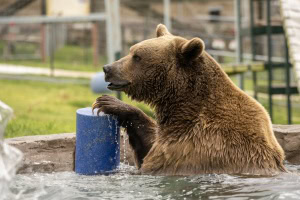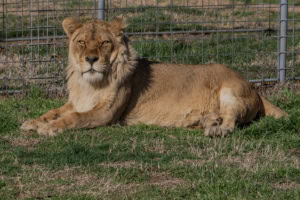When someone visits a zoo or sanctuary, or watches a wildlife documentary, they may ask the question: How long do the animals live? The answer is not always straightforward. Some animals, such as birds, don’t show their age the way we do. Others can live longer than any human, which means we can only make an educated guess.
Still, we can make a decent estimate of many animals’ lifespans. Larger animals, for the most part, tend to live longer than smaller ones. This, of course, is not always accurate – there are always exceptions – but it does provide us with a decent starting point. Predation is one possible reason for this pattern – larger animals are generally preyed upon less than smaller ones. Metabolic rate plays another role: Smaller animals tend to have a faster metabolic rate, which is thought to lead to a shorter lifespan.
Animals at TCWR
Here at Turpentine Creek, we are home to several species of cats, both big and small. While there is some variation, most cats have a lifespan somewhere between ten to fifteen years in the wild, and roughly fifteen to twenty in captivity. There isn’t much of a difference between males and females, with the exception of lions: Female lions generally live longer than the males.
Bears live longer than cats. While they can live to be thirty years in the wild, the majority don’t make it that long. Most wild black bears die before they reach their twenties. Still, bears in captivity have been known to reach forty. Spotted hyenas have a similar lifespan: roughly twenty in the wild, up to forty in captivity. The other three hyena species – striped hyenas, brown hyenas and aardwolves – generally live shorter lives.

Wild vs. Captivity
Why do animals, for the most part, live longer in captivity than in the wild? There are a number of possible reasons. In the wild, they face challenges such as predation, food shortages, drought, a harsh climate, and competition with other animals. In captivity, these challenges are lessened, and there is also veterinary care in case of injury or illness. This of course depends on the quality of care they receive. But when it comes to care, a long lifespan isn’t enough. The quality of a captive animal’s life is perhaps the most important factor to consider.

The answer to the question of how long animals live is a long and complicated one. It is often difficult to know for sure, especially when the animal is elusive and difficult to find. For a long time, we really only knew about animal lifespans in captivity. It is only more recently that we have started to discover answers for those in their natural habitats.
Sources
https://abcbirds.org/blog21/bird-longevity
https://tpwd.texas.gov/publications/nonpwdpubs/young_naturalist/animals/animal_life_spans/
https://www.discoverymedicine.com/S-J-Olshansky/2009/07/25/what-determines-longevity-metabolic-rate-or-stability/
https://nationalzoo.si.edu/animals/tiger
https://nationalzoo.si.edu/animals/lion
https://www.nwf.org/Educational-Resources/Wildlife-Guide/Mammals/Black-Bear
https://www.alaskazoo.org/brown-bears-black-bears
https://animaldiversity.org/accounts/Crocuta_crocuta/
https://phys.org/news/2016-11-mammals-greater-life-zoos.html
*Published by Eryn Meeker on 05/17/2025*